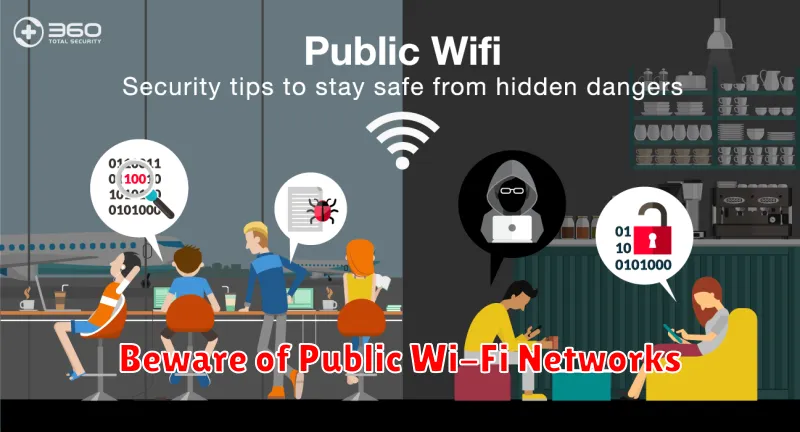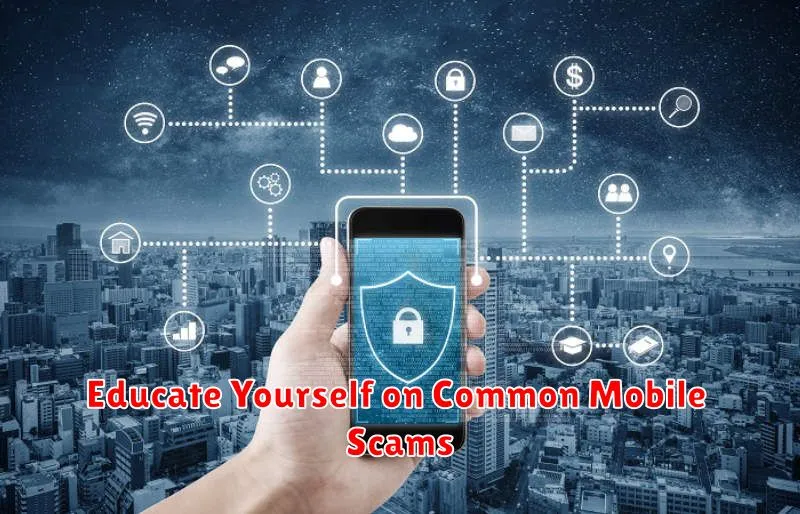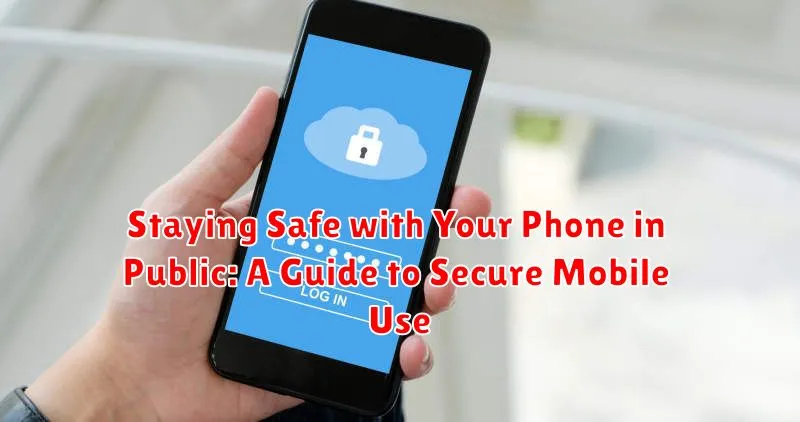In today’s interconnected world, our phones are indispensable tools, connecting us to information, resources, and each other. However, this constant connectivity also presents security risks, particularly when using our phones in public spaces. This guide provides practical advice and essential tips for staying safe and protecting your personal information while using your phone in public. From understanding common mobile threats to implementing security measures, we’ll cover everything you need to know to ensure a secure mobile experience.
Staying safe with your phone in public requires vigilance and proactive measures. This article addresses key concerns such as protecting against theft, securing your data, and maintaining privacy while using your phone on the go. Learn how to mitigate risks associated with public Wi-Fi, avoid shoulder surfing, and implement strong passwords and authentication methods. By following these guidelines, you can confidently use your phone in public while minimizing your exposure to potential security threats.
Be Aware of Your Surroundings
Situational awareness is your first line of defense against phone theft. Before using your phone in public, take a moment to assess your surroundings. Are you in a crowded area? Are there people loitering nearby? Trust your instincts. If a situation feels unsafe, avoid using your phone altogether.
Minimize distractions when using your phone. Avoid wearing headphones or earbuds, as this can limit your awareness of approaching threats. Keep your eyes up and scan your environment regularly while using your device. Be particularly cautious in areas with limited visibility or escape routes.
Be mindful of who’s around you when making calls. Avoid discussing sensitive personal or financial information in public places where others can overhear. If you need to have a private conversation, move to a more secure location or wait until you are in a private setting.
Keep Your Phone Securely Stored
Minimizing phone visibility is a key aspect of public safety. When not in use, your phone should be stored out of sight. Avoid leaving it in easy-to-grab locations like back pockets or open bags.
Invest in a secure bag or purse that closes completely, preferably with a zipper or secure clasp. Consider bags with dedicated phone compartments that offer an extra layer of protection. Inside jackets and front pockets are generally safer than back pockets.
When sitting down, particularly in crowded areas like restaurants or public transport, be mindful of where your phone is placed. Avoid leaving it on tables or in open areas where it can be easily snatched. Keep it in a secure bag or on your lap, beneath a jacket or bag.
Use Strong Passwords and Biometrics
Protecting your phone with a strong password is the first line of defense against unauthorized access. Avoid easily guessable passwords like “1234” or your birthday. Instead, opt for a complex password that includes a mix of uppercase and lowercase letters, numbers, and symbols.
Consider using a password manager to generate and securely store complex passwords for all your accounts. This eliminates the need to memorize multiple difficult passwords.
Biometric security features, such as fingerprint or facial recognition, offer an added layer of protection. Enable these features if your device supports them. Biometrics can make accessing your phone quicker and more secure than typing a password, particularly in public spaces.
Regularly update your passwords and biometrics. This simple practice significantly strengthens your phone’s security and reduces vulnerability to evolving threats.
Avoid Displaying Sensitive Information Publicly
Protecting your privacy in public spaces extends to being mindful of the information visible on your phone’s screen. Avoid openly displaying sensitive data such as banking details, passwords, or private messages. Shoulder surfing, where someone nearby observes your screen, can easily compromise your security.
When entering passwords or viewing sensitive information, be discreet and shield your screen from onlookers. Consider using a privacy screen protector which makes it difficult for anyone not directly in front of the device to see the display. This adds an extra layer of protection against prying eyes.
Furthermore, be cautious about the information you access while in public. Refrain from logging into sensitive accounts like banking apps or email accounts that contain personal information unless absolutely necessary. If you must access these accounts, ensure your surroundings are secure and private.
Beware of Public Wi-Fi Networks

Public Wi-Fi hotspots are convenient, but they also pose security risks. These networks often lack robust encryption, making your data vulnerable to interception by malicious actors. Avoid accessing sensitive information, such as online banking or making online purchases, while connected to public Wi-Fi.
If you must use public Wi-Fi, take precautions to protect your data. Consider using a virtual private network (VPN). A VPN creates a secure, encrypted connection between your device and the internet, shielding your data from prying eyes. Look for reputable VPN providers with strong security protocols.
Verify the network name. Cybercriminals may set up fake Wi-Fi hotspots with names similar to legitimate ones. Double-check the network name with the establishment providing the Wi-Fi before connecting.
Disable automatic connection to Wi-Fi. This prevents your phone from automatically joining unfamiliar and potentially insecure networks.
Install Security Software and Keep It Updated
Security software plays a crucial role in safeguarding your phone from various threats like malware and viruses. Choosing and utilizing reputable security software is the first step in protecting your device.
Select a well-known and trusted security app from your device’s app store. Read reviews and compare features to find the best fit for your needs. Once installed, ensure the software is configured to provide real-time protection and automatic scanning.
Keeping your security software up-to-date is just as important as installing it. Regular updates patch security vulnerabilities that malicious actors could exploit. Enable automatic updates to ensure you always have the latest protection. Periodically check for updates manually if the automatic update feature isn’t available or enabled.
By following these steps, you add an extra layer of protection to your device, mitigating the risks associated with using your phone in public spaces.
Be Cautious of Shoulder Surfers
Shoulder surfing is a common tactic used by thieves to steal your personal information, such as PINs, passwords, and credit card details, by simply looking over your shoulder while you’re using your phone in public.
Be aware of your surroundings and the people around you. When entering sensitive information like passwords or credit card numbers, shield your screen with your hand or body. This simple action can effectively prevent prying eyes from stealing your information.
Choose strong, unique passwords and avoid using easily guessable information like birthdays or pet names. Consider using a password manager to generate and store complex passwords securely.
Be extra vigilant in crowded places like public transportation, cafes, and airports, where shoulder surfers are more likely to operate.
Enable Find My iPhone/Android
One of the most effective ways to protect your phone is by enabling the “Find My” feature (Find My iPhone for iOS devices, Find My Device for Android). This feature allows you to locate your phone remotely if it’s lost or stolen, offering a crucial safety net.
Activating this feature is simple. For iPhones, go to Settings > [Your Name] > Find My > Find My iPhone and toggle it on. For Android devices, navigate to Settings > Security & location > Find My Device and ensure it’s activated. This allows you to see your phone’s location on a map, play a sound (even if it’s on silent), lock it remotely, and even erase its data to protect your personal information if necessary. Remember to keep this feature enabled at all times for optimal security.
Beyond simply locating a misplaced phone, this feature can be vital in deterring theft. Knowing their device can be tracked can discourage thieves from targeting your phone.
Report Lost or Stolen Devices Immediately
The moment you realize your device is missing, take immediate action. Time is of the essence in preventing unauthorized access and potential misuse of your personal information.
First, if you have a tracking feature enabled (like Find My iPhone or Find My Device for Android), use it to locate your phone and potentially remotely lock or erase it. This can protect your data and make the device less appealing to thieves.
Next, report the loss or theft to your wireless carrier immediately. They can suspend your service, preventing unauthorized calls and data usage. This can also protect you from financial liability for any charges incurred after the theft.
You should also file a police report. This creates an official record of the incident and might be necessary for insurance claims. Provide them with as much information as possible, including the device’s make, model, serial number (if you have it), and the circumstances of the loss or theft.
Finally, change your passwords for all important accounts accessed through your phone, such as email, social media, and banking apps. This adds an extra layer of security and mitigates the risk of unauthorized access even if the device is recovered.
Educate Yourself on Common Mobile Scams

Knowledge is your best defense against mobile scams. Familiarizing yourself with common tactics can prevent you from becoming a victim.
Phishing attacks often arrive via text message or email, masquerading as legitimate institutions. These messages attempt to trick you into revealing personal information like passwords and credit card numbers. Be wary of any unsolicited requests for sensitive data.
Malicious apps can disguise themselves as harmless games or tools. Always download apps from official app stores and carefully review the permissions they request.
Smishing (SMS phishing) uses text messages to lure you into clicking on dangerous links or calling fraudulent numbers. Be suspicious of urgent messages demanding immediate action.
One-ring scams involve a missed call from an international number. Returning the call often results in hefty charges. Avoid calling back numbers you don’t recognize, especially international ones.

